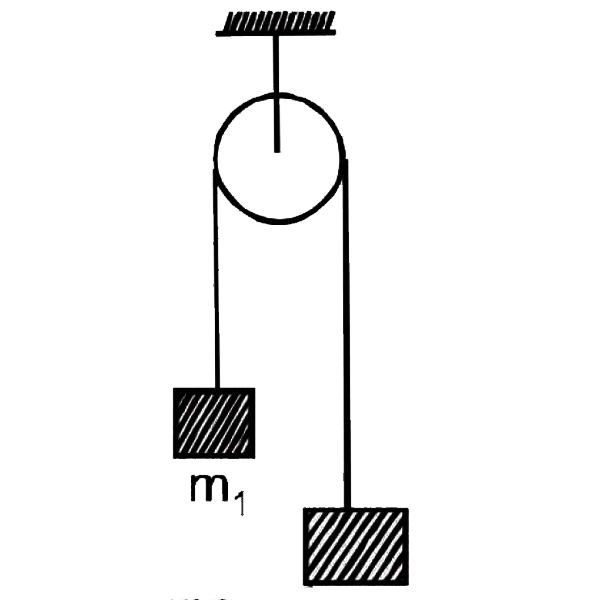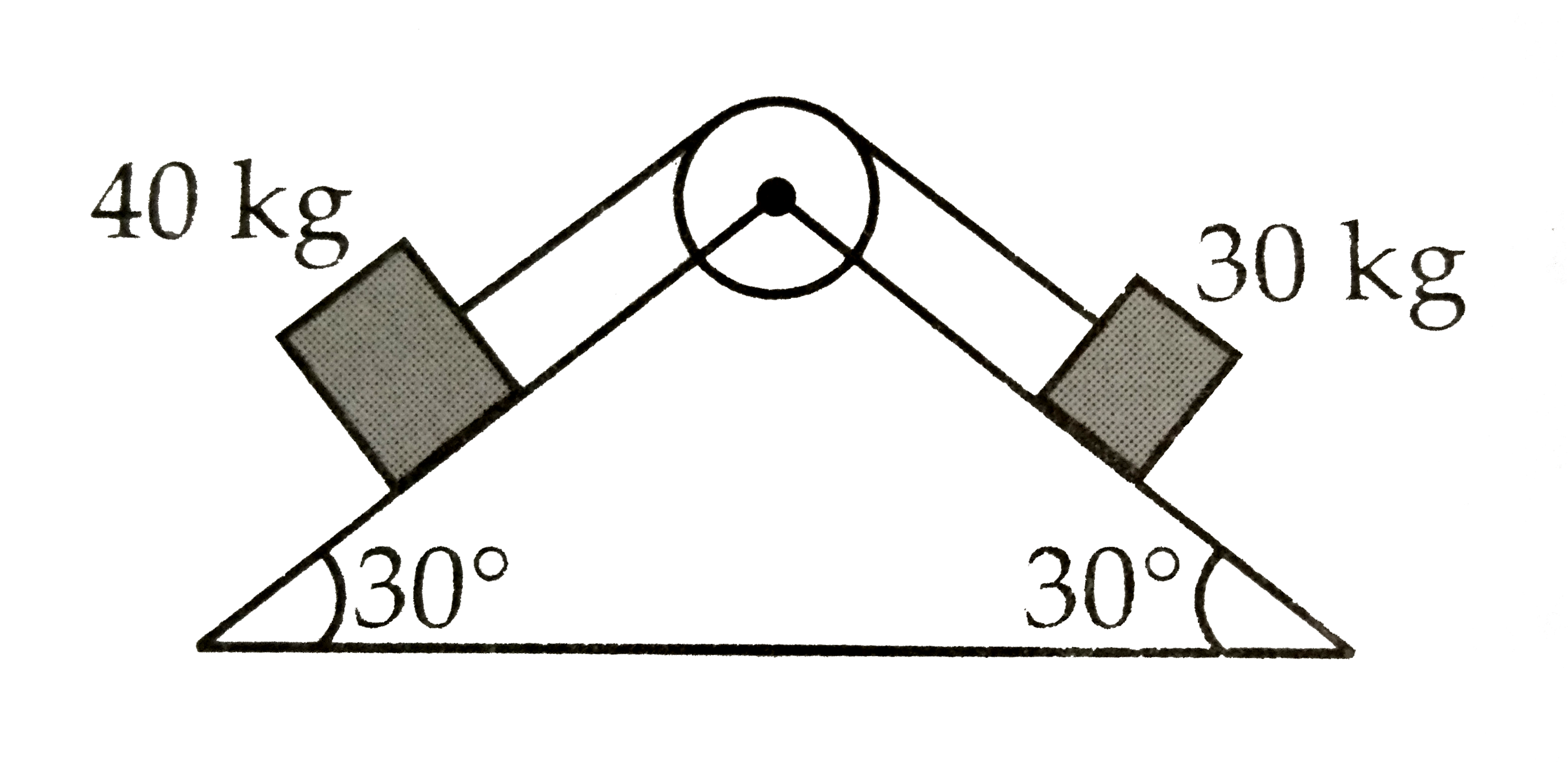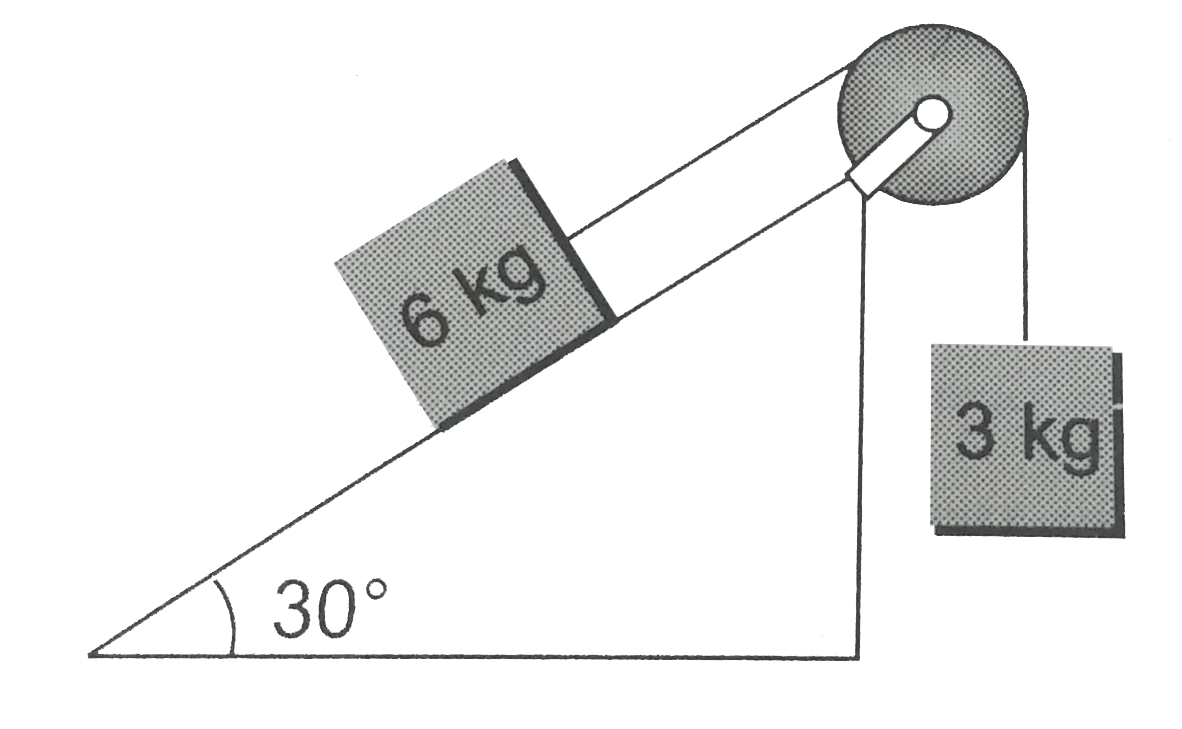Two blocks of masses 2 kg and 4 kg tied to a string passing over a frictionless pulley. What will be the magnitude of acceleration of the masses, when they are allowed to move freely?
To solve the problem of two blocks of masses 2 kg and 4 kg tied to a string passing over a frictionless pulley, we will follow these steps:
1. Identify the masses and their weights:
- Mass m1=2kg
- Mass m2=4kg
- Weight of m1 (2 kg): W1=m1⋅g=2⋅9.8=19.6N
- Weight of m2 (4 kg): W2=m2⋅g=4⋅9.8=39.2N
2. Determine the direction of motion:
- Since m2 (4 kg) is heavier than m1 (2 kg), m2 will move downward and m1 will move upward.
3. Set up the equations of motion:
- For the 4 kg mass (moving downward):
W2−T=m2⋅a(1)
- For the 2 kg mass (moving upward):
T−W1=m1⋅a(2)
4. Substitute the weights into the equations:
- From equation (1):
39.2−T=4a(3)
- From equation (2):
T−19.6=2a(4)
5. Solve for tension T from equation (4):
T=2a+19.6(5)
6. Substitute equation (5) into equation (3):
39.2−(2a+19.6)=4a
39.2−19.6−2a=4a
19.6=6a
7. Solve for acceleration a:
a=19.66≈3.27m/s2
8. Final answer:
The magnitude of the acceleration of the masses when they are allowed to move freely is approximately 3.27m/s2.
- Mass m1=2kg
- Mass m2=4kg
- Weight of m1 (2 kg): W1=m1⋅g=2⋅9.8=19.6N
- Weight of m2 (4 kg): W2=m2⋅g=4⋅9.8=39.2N
- Since m2 (4 kg) is heavier than m1 (2 kg), m2 will move downward and m1 will move upward.
- For the 4 kg mass (moving downward):
W2−T=m2⋅a(1)
- For the 2 kg mass (moving upward):
T−W1=m1⋅a(2)
- From equation (1):
39.2−T=4a(3)
- From equation (2):
T−19.6=2a(4)
T=2a+19.6(5)
39.2−(2a+19.6)=4a
39.2−19.6−2a=4a
19.6=6a
a=19.66≈3.27m/s2
The magnitude of the acceleration of the masses when they are allowed to move freely is approximately 3.27m/s2.
Similar Questions
Two masses m1=5kg and m2=4.8kg tied to a string are hanging over a light frictionless pulley. What is the acceleration of the masses when left free to move?

View SolutionTwo bodies of masses 4 kg and 6 kg are tied to the ends of a massless string. The string passes over a frictionless pulley. The acceleration of the system is :
View Solution
Knowledge Check
Two blocks of masses of 40 kg and 30 kg are connected by a weightless string passing over a frictionless pulley as shown in the figure.
 A0.7ms−2B0.8ms−2C0.6ms−2D0.5ms−2
A0.7ms−2B0.8ms−2C0.6ms−2D0.5ms−2
Two blocks of masses m1andm2(m1>m2) connected by a massless string passing over a frictionless pulley Magnitude of acceleration of blocks would be
View SolutionTwo blocks of masses 3 kg and 6 kg are connected by a string as shown in the figure over a frictionless pulley. The acceleration of the system is

A. 4m/s2
B. 2m/s2
C. zero
D. 6m/s2
View SolutionTwo blocks of masses 6kg and 4kg are attached to the two ends of a massless string passing over a smooth fixed pulley. if the system is released, the acceleration of the centre of mass of the system will be
View SolutionTwo masses of 3 kg and 4 kg are connected at the two ends of a light inextensible string that passes over a frictionless pulley. Find the acceleration of the masses and the tension in the string, when the masses are released.
View SolutionTwo blocks of masses 2kg and 5kg are at rest on ground. The masses are connected by a string passing over a frictionless pulley which is under the influence of a constant upward force F = 50 N. Find the accelerations of 5kg and 2kg masses.
View SolutionTwo masses 2 kg and 4 kg are connected at the two ends of light inextensible string passing over a frictionless pulley. If the masses are released, then find the acceleration of the masses and the tension in the string.
View SolutionTwo masses 2 kg and 4 kg are connected at two ends of light inextensible string passing over a frictionless pulley . If the masses are released , then find the accelaration of the masses and the tension in the string .
View Solution
